Negative polarity CH HSS sparks G2 – Moderate geomagnetic storm
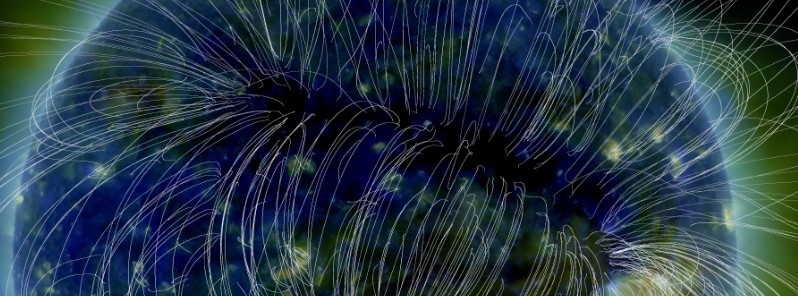
A persistent negative polarity coronal hole high speed stream (CH HSS) sparked G2 – Moderate geomagnetic storm on March 18, 2018. A gradual return to background levels is expected on March 19 as CH HSS influence subsides. However, enhanced solar wind parameters are expected to return by early March 20 and further increase on March 21 due to influence of a series of negative polarity CH HSSs.
Solar wind parameters reflected continued influence of a negative polarity CH HSS on March 18, 2018. Solar wind speeds averaged about 500 km/s through about 14:15 UTC when an increase to about 550 – 590 km/s was observed.
Total field strength generally ranged between 1 – 5 nT with an enhancement of near 11 nT at 13:54 UTC. The Bz component varied weakly between +/- 3 nT with increased variability between +/- 8 nT evident after 14:00 UTC.
Solar wind parameters are expected to gradually return to background levels today as CH HSS influence subsides.
However, enhanced solar wind parameters are expected to return by early March 20 and further increase on March 21 due to influence of a series of negative polarity CH HSSs.
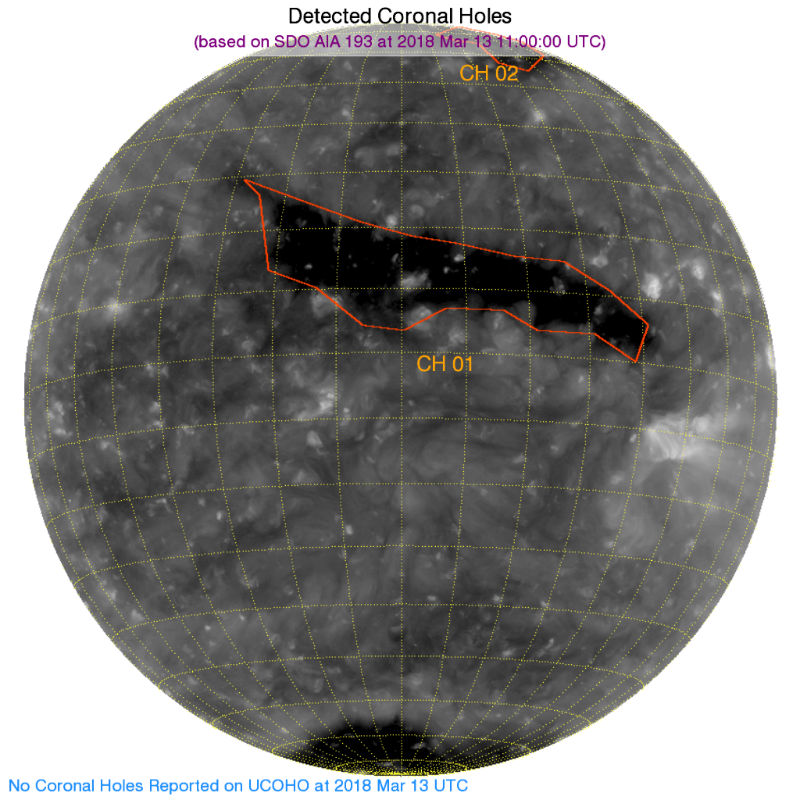
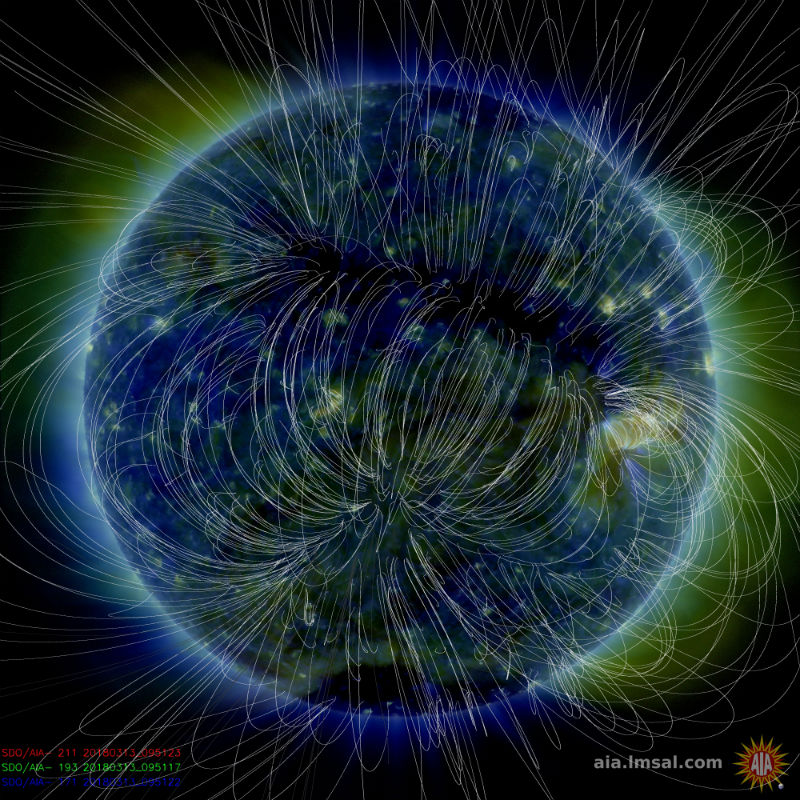
The greater than 2 MeV electron flux reached high levels with a maximum flux of 5 070 pfu observed at 00:10 UTC on March 18. It is expected to reach high levels on March 19 and 20 too following a period of enhanced solar winds. A return to normal to moderate levels is anticipated on March 21 due to electron distribution.
The greater than 10 MeV proton flux is steady at background levels.
The geomagnetic field ranged from quiet to G2 – Moderate storm levels under persistent CH HSS influence on March 18. G2 – Moderate storm levels were observed during the 21:00 – 24:00 UTC period.
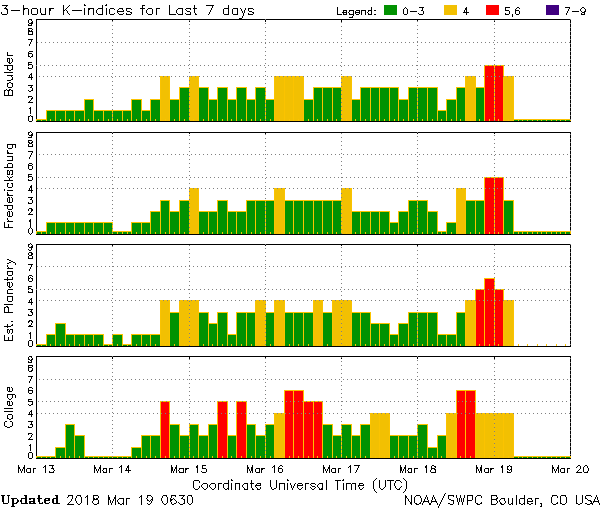
The geomagnetic field is expected to be at G1 – G2 (Minor – Moderate) storm levels early March 19 followed by quiet to active levels under persistent CH HSS influence.
Activity levels are expected to be at quiet to unsettled levels on March 20, increasing to quiet to active levels by March 21 due to the influence of abovementioned negative polarity CH HSSs.
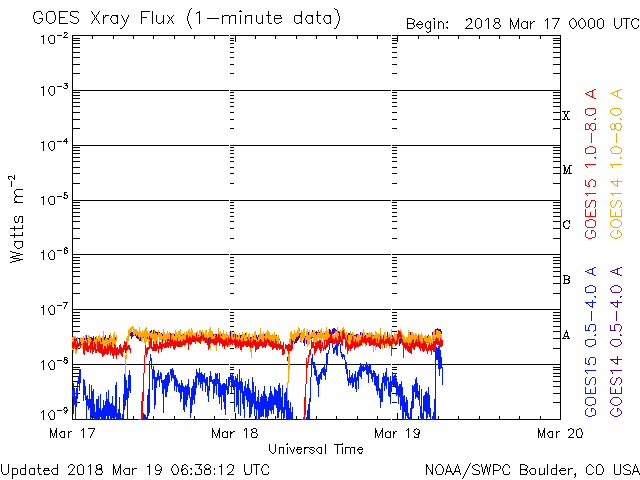
Solar activity was very low over the past 36 hours and is expected to remain at very low levels over the next three days. There is only one numbered active region (AR 2702) on the Earth side of the Sun.
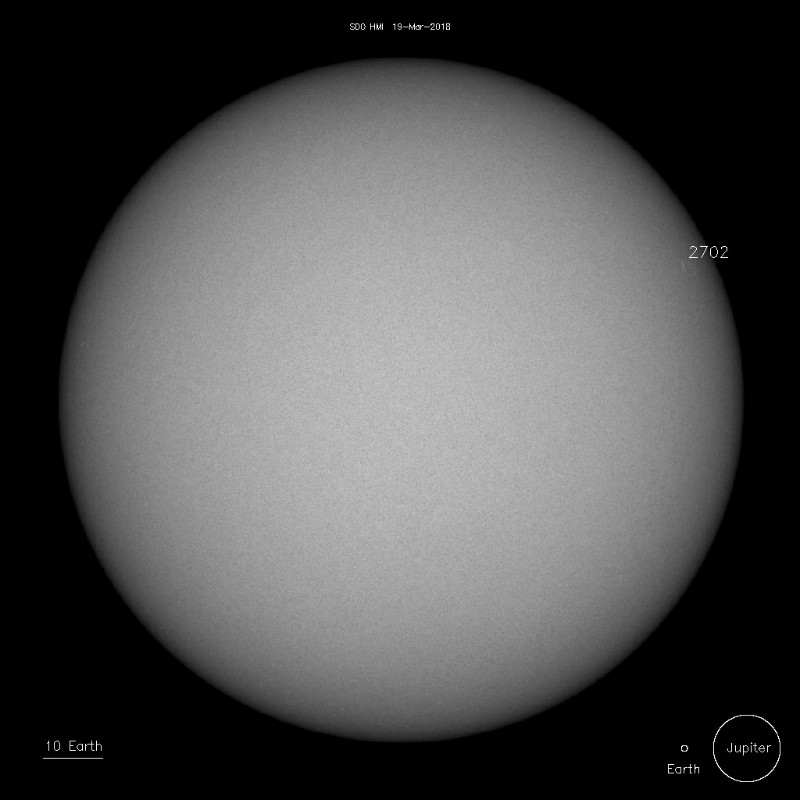
Sunspots on March 19, 2018. Credit: NASA SDO/HMI
This region has 'beta' magnetic configuration and was quiet and stable over the past 24 hours. Its farside rotation is expected to begin within a few days, leaving us with a spotless Sun again.
SWPC Alerts, Watches and Warnings
Space Weather Message Code: ALTK05
Serial Number: 1211
Issue Time: 2018 Mar 19 0207 UTC
ALERT: Geomagnetic K-index of 5
Threshold Reached: 2018 Mar 19 0202 UTC
Synoptic Period: 0000-0300 UTC
Active Warning: Yes
NOAA Scale: G1 – Minor
NOAA Space Weather Scale descriptions can be found at
www.swpc.noaa.gov/noaa-scales-explanation
Potential Impacts: Area of impact primarily poleward of 60 degrees Geomagnetic Latitude.
Induced Currents – Weak power grid fluctuations can occur.
Spacecraft – Minor impact on satellite operations possible.
Aurora – Aurora may be visible at high latitudes, i.e., northern tier of the U.S. such as northern Michigan and Maine.
***
Space Weather Message Code: ALTK06
Serial Number: 459
Issue Time: 2018 Mar 18 2200 UTC
ALERT: Geomagnetic K-index of 6
Threshold Reached: 2018 Mar 182159 UTC
Synoptic Period: 2100-2400 UTC
Active Warning: Yes
NOAA Scale: G2 – Moderate
NOAA Space Weather Scale descriptions can be found at
www.swpc.noaa.gov/noaa-scales-explanation
Potential Impacts: Area of impact primarily poleward of 55 degrees Geomagnetic Latitude.
Induced Currents – Power grid fluctuations can occur. High-latitude power systems may experience voltage alarms.
Spacecraft – Satellite orientation irregularities may occur; increased drag on low Earth-orbit satellites is possible.
Radio – HF (high frequency) radio propagation can fade at higher latitudes.
Aurora – Aurora may be seen as low as New York to Wisconsin to Washington state.
***
Space Weather Message Code: WARK05
Serial Number: 1463
Issue Time: 2018 Mar 18 2141 UTC
EXTENDED WARNING: Geomagnetic K-index of 5 expected
Extension to Serial Number: 1462
Valid From: 2018 Mar 18 2047 UTC
Now Valid Until: 2018 Mar 19 0600 UTC
Warning Condition: Persistence
NOAA Space Weather Scale descriptions can be found at
www.swpc.noaa.gov/noaa-scales-explanation
Potential Impacts: Area of impact primarily poleward of 60 degrees Geomagnetic Latitude.
Induced Currents – Weak power grid fluctuations can occur.
Spacecraft – Minor impact on satellite operations possible.
Aurora – Aurora may be visible at high latitudes, i.e., northern tier of the U.S. such as northern Michigan and Maine.
***
Space Weather Message Code: WARK04
Serial Number: 3445
Issue Time: 2018 Mar 18 2141 UTC
EXTENDED WARNING: Geomagnetic K-index of 4 expected
Extension to Serial Number: 3444
Valid From: 2018 Mar 18 1430 UTC
Now Valid Until: 2018 Mar 19 1200 UTC
Warning Condition: Persistence
NOAA Space Weather Scale descriptions can be found at
www.swpc.noaa.gov/noaa-scales-explanation
Potential Impacts: Area of impact primarily poleward of 65 degrees Geomagnetic Latitude.
Induced Currents – Weak power grid fluctuations can occur.
Aurora – Aurora may be visible at high latitudes such as Canada and Alaska.
***
Space Weather Message Code: WARK06
Serial Number: 415
Issue Time: 2018 Mar 18 2141 UTC
WARNING: Geomagnetic K-Index of 6 expected
Valid From: 2018 Mar 18 2141 UTC
Valid To: 2018 Mar 19 0300 UTC
Warning Condition: Onset
NOAA Scale: G2 – Moderate
NOAA Space Weather Scale descriptions can be found at
www.swpc.noaa.gov/noaa-scales-explanation
Potential Impacts: Area of impact primarily poleward of 55 degrees Geomagnetic Latitude.
Induced Currents – Power grid fluctuations can occur. High-latitude power systems may experience voltage alarms.
Spacecraft – Satellite orientation irregularities may occur; increased drag on low Earth-orbit satellites is possible.
Radio – HF (high frequency) radio propagation can fade at higher latitudes.
Aurora – Aurora may be seen as low as New York to Wisconsin to Washington state.
***
Space Weather Message Code: ALTK05
Serial Number: 1210
Issue Time: 2018 Mar 18 2136 UTC
ALERT: Geomagnetic K-index of 5
Threshold Reached: 2018 Mar 18 2136 UTC
Synoptic Period: 2100-2400 UTC
Active Warning: Yes
NOAA Scale: G1 – Minor
NOAA Space Weather Scale descriptions can be found at
www.swpc.noaa.gov/noaa-scales-explanation
Potential Impacts: Area of impact primarily poleward of 60 degrees Geomagnetic Latitude.
Induced Currents – Weak power grid fluctuations can occur.
Spacecraft – Minor impact on satellite operations possible.
Aurora – Aurora may be visible at high latitudes, i.e., northern tier of the U.S. such as northern Michigan and Maine.
***
Space Weather Message Code: ALTK05
Serial Number: 1209
Issue Time: 2018 Mar 18 2052 UTC
ALERT: Geomagnetic K-index of 5
Threshold Reached: 2018 Mar 18 2052 UTC
Synoptic Period: 1800-2100 UTC
Active Warning: Yes
NOAA Scale: G1 – Minor
NOAA Space Weather Scale descriptions can be found at
www.swpc.noaa.gov/noaa-scales-explanation
Potential Impacts: Area of impact primarily poleward of 60 degrees Geomagnetic Latitude.
Induced Currents – Weak power grid fluctuations can occur.
Spacecraft – Minor impact on satellite operations possible.
Aurora – Aurora may be visible at high latitudes, i.e., northern tier of the U.S. such as northern Michigan and Maine.
***
Space Weather Message Code: WARK05
Serial Number: 1462
Issue Time: 2018 Mar 18 2047 UTC
WARNING: Geomagnetic K-index of 5 expected
Valid From: 2018 Mar 18 2047 UTC
Valid To: 2018 Mar 18 2359 UTC
Warning Condition: Onset
NOAA Scale: G1 – Minor
NOAA Space Weather Scale descriptions can be found at
www.swpc.noaa.gov/noaa-scales-explanation
Potential Impacts: Area of impact primarily poleward of 60 degrees Geomagnetic Latitude.
Induced Currents – Weak power grid fluctuations can occur.
Spacecraft – Minor impact on satellite operations possible.
Aurora – Aurora may be visible at high latitudes, i.e., northern tier of the U.S. such as northern Michigan and Maine.
***
Space Weather Message Code: ALTK04
Serial Number: 2043
Issue Time: 2018 Mar 18 1630 UTC
ALERT: Geomagnetic K-index of 4
Threshold Reached: 2018 Mar 18 1630 UTC
Synoptic Period: 1500-1800 UTC
Active Warning: Yes
NOAA Space Weather Scale descriptions can be found at
www.swpc.noaa.gov/noaa-scales-explanation
Potential Impacts: Area of impact primarily poleward of 65 degrees Geomagnetic Latitude.
Induced Currents – Weak power grid fluctuations can occur.
Aurora – Aurora may be visible at high latitudes such as Canada and Alaska.
***
Space Weather Message Code: WARK04
Serial Number: 3444
Issue Time: 2018 Mar 18 1429 UTC
WARNING: Geomagnetic K-index of 4 expected
Valid From: 2018 Mar 18 1430 UTC
Valid To: 2018 Mar 18 2359 UTC
Warning Condition: Onset
NOAA Space Weather Scale descriptions can be found at
www.swpc.noaa.gov/noaa-scales-explanation
Potential Impacts: Area of impact primarily poleward of 65 degrees Geomagnetic Latitude.
Induced Currents – Weak power grid fluctuations can occur.
Aurora – Aurora may be visible at high latitudes such as Canada and Alaska.
***
Space Weather Message Code: ALTEF3
Serial Number: 2741
Issue Time: 2018 Mar 18 0859 UTC
CONTINUED ALERT: Electron 2MeV Integral Flux exceeded 1000pfu
Continuation of Serial Number: 2740
Begin Time: 2018 Mar 16 0105 UTC
Yesterday Maximum 2MeV Flux: 7565 pfu
NOAA Space Weather Scale descriptions can be found at
www.swpc.noaa.gov/noaa-scales-explanation
Potential Impacts: Satellite systems may experience significant charging resulting in increased risk to satellite systems.
***
Space Weather Message Code: WARK04
Serial Number: 3443
Issue Time: 2018 Mar 17 2229 UTC
WARNING: Geomagnetic K-index of 4 expected
Valid From: 2018 Mar 17 2230 UTC
Valid To: 2018 Mar 18 0300 UTC
Warning Condition: Onset
NOAA Space Weather Scale descriptions can be found at
www.swpc.noaa.gov/noaa-scales-explanation
Potential Impacts: Area of impact primarily poleward of 65 degrees Geomagnetic Latitude.
Induced Currents – Weak power grid fluctuations can occur.
Aurora – Aurora may be visible at high latitudes such as Canada and Alaska.
***
Space Weather Message Code: ALTEF3
Serial Number: 2740
Issue Time: 2018 Mar 17 0744 UTC
CONTINUED ALERT: Electron 2MeV Integral Flux exceeded 1000pfu
Continuation of Serial Number: 2739
Begin Time: 2018 Mar 16 0105 UTC
Yesterday Maximum 2MeV Flux: 13798 pfu
NOAA Space Weather Scale descriptions can be found at
www.swpc.noaa.gov/noaa-scales-explanation
Potential Impacts: Satellite systems may experience significant charging resulting in increased risk to satellite systems.
Featured image credit: NASA SDO/AIA

Commenting rules and guidelines
We value the thoughts and opinions of our readers and welcome healthy discussions on our website. In order to maintain a respectful and positive community, we ask that all commenters follow these rules.